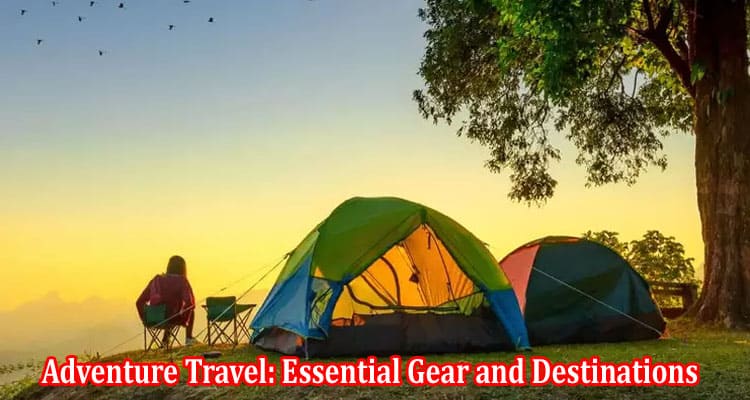Adventure travel is more than just a way to break from the routine; it’s a journey into the unknown, offering transformative experiences and the thrill of discovery. For such ventures, meticulous planning, focusing on safety and preparedness, is essential. An often overlooked but crucial aspect of this preparation is securing comprehensive travel insurance, which offers protection against various uncertainties and challenges that may arise. This guide delves into the essentials of gear and destination planning, ensuring adventurers are well-equipped for their journey, both physically and in terms of preparation.
Choosing the Right Gear
The right gear is your ally in the wilderness and unfamiliar territories. Beyond the basics, consider the specific requirements of your activities. For example, if you’re going on a trekking expedition, invest in gear specifically designed for hiking, such as lightweight, moisture-wicking clothing and a sturdy yet comfortable backpack. For water-based adventures, items like dry bags, waterproof cases for electronics, and appropriate swimwear are essential. Remember, the right gear should enhance your experience, not hinder it, so choose items proven reliable and suited to your particular adventure.
Footwear for Different Terrains
Your choice of footwear can make or break an adventure travel experience. For mountainous adventures, boots with good ankle support and grip are essential. Waterproof or quick-drying shoes are crucial if your journey involves crossing streams or wet conditions. In desert or hot climates, breathable footwear that protects from the heat and sand is necessary. Remember, the terrain dictates the type of footwear needed, so research the landscape of your destination thoroughly and invest in quality footwear designed for those specific conditions.
Weather-Appropriate Clothing
Adapting your clothing to the weather of your destination is vital. Lightweight, breathable fabrics with UV protection are advisable in hot and sunny climates. For cold-weather adventures, thermal wear, insulated jackets, and layering are vital in maintaining body heat. In areas with unpredictable weather, carry clothing that can adapt to changing conditions, such as convertible trousers or layered clothing that can be easily added or removed. Always plan for the worst-case scenario weather-wise to ensure you’re not caught off guard.
Essential Navigation Tools
In adventure travel, navigating effectively is crucial. GPS devices are helpful but should only partially replace traditional navigation tools like maps and compasses, which don’t rely on battery power or signal reception. Familiarize yourself with the topography and landmarks of your destination before departure. Learning basic navigation skills, such as reading maps and using a compass, is invaluable and can enhance your overall travel experience.
Safety and First Aid
A comprehensive approach to safety involves planning for various scenarios. Research the potential hazards of your destination, such as wildlife encounters, and know how to respond appropriately. Your first aid kit should be tailored to the specific environment and include insect repellent, sun protection, and personal medications. Consider taking an introductory first aid course, especially if traveling to remote areas where medical help is unavailable. Additionally, inform someone about your travel itinerary and expected return time.
Understanding the Importance of Comprehensive Travel Insurance
Comprehensive travel insurance is indispensable in safeguarding your adventure. This insurance typically covers medical emergencies, which can be expensive in foreign countries, especially in remote areas where evacuation may be required. It also covers other risks like trip cancellations, delays, and lost or stolen baggage. For adventure travelers engaging in high-risk activities, ensure that your insurance policy explicitly covers these activities. A thorough understanding of your policy’s terms and conditions is essential so that you know exactly what is covered.
Top Destinations for Adventure Travel
Selecting the right destination is crucial for an enriching adventure travel experience. For trekking enthusiasts, destinations like the Himalayas in Nepal or the Andes in South America offer unparalleled hiking experiences. Water sports lovers might find destinations like Bali or Costa Rica ideal for surfing and diving. For people interested in wildlife, an African safari or a trip to the Galapagos Islands could be the adventure of a lifetime. Research destinations that align not just with your adventure interests but also with your skill level and experience.
Camping and Outdoor Cooking Skills
Camping and outdoor cooking skills are invaluable when embarking on an adventure trip, especially those involving remote or wilderness locations. Knowing how to set up a campsite, pitch a tent, build a fire, and prepare meals in the great outdoors enhances your self-sufficiency and connects you more intimately with nature.
Invest in good camping gear, such as a reliable tent, a portable camping stove, and cookware designed for outdoor use. Learning how to purify water from natural sources and safely store food in bear-resistant containers, where applicable, is essential for outdoor enthusiasts.
Camping allows you to immerse yourself fully in the environment, whether under the starlit skies of the desert, in the dense forests, or by the serene lakesides. Enjoy delicious meals prepared over an open flame while disconnecting from the modern world.
Conclusion
Adventure travel is an opportunity to explore, learn, and challenge oneself. It’s a journey that needs careful planning, from selecting the right gear and destination to ensuring safety with comprehensive travel insurance. By being well-prepared, adventurers can immerse themselves fully in their experiences and be confident in their ability to handle the challenges and joys of exploring the unknown. Adventure travel isn’t just about the destinations; it’s about the journey and the growth that occurs along the way.




